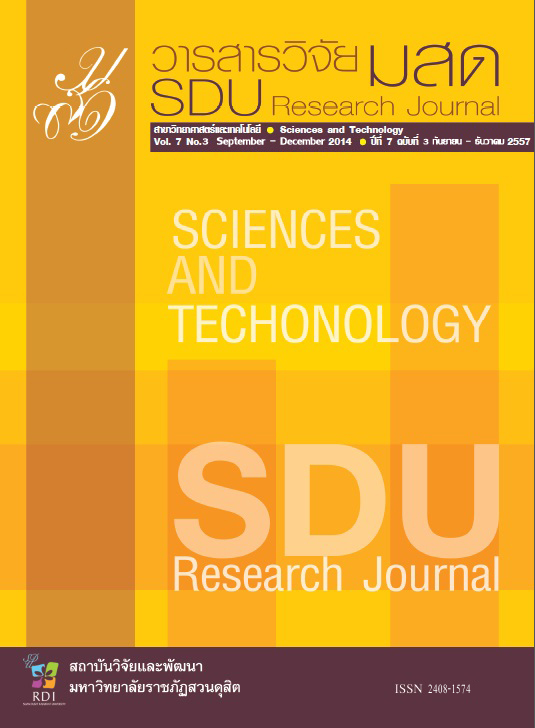การศึกษาระบบการเพาะปลูกเพื่อเพิ่มผลผลิตมันสำปะหลัง
Keywords:
มันสำปะหลัง, อินทรีย์, อุทัยธานีAbstract
บทคัดย่อ
จังหวัดอุทัยธานีมีการเพาะปลูกมันสำปะหลังมายาวนานหลายสิบปี โดยรูปแบบในการเพาะปลูกเป็นรูปแบบของการใช้สารเคมีทั้งสิ้น ทำให้เกษตรกรมีรายจ่ายสูงจากการซื้อปุ๋ยเคมี ยาฆ่าแมลง และสารเร่งอื่นๆ เพื่อเร่งให้มันสำปะหลังโตเร็ว มีคุณภาพแป้งที่ดี อันนำมาสู่ผลกระทบที่ตามมาหลายประการ เช่น ดินเสื่อมสภาพ สารตกค้างในมันสำปะหลัง และการได้รับสารพิษสะสมในร่างกายของเกษตรกรที่อาจส่งผลต่อปัญหาสุขภาพในระยะยาวต่อไปดังนั้นการศึกษาครั้งนี้จึงมีวัตถุประสงค์เพื่อศึกษาระบบการเพาะปลูกเพื่อเพิ่มผลผลิตมันสำปะหลังในการนำไปใช้เป็นต้นแบบแก่เกษตรกรในจังหวัดอุทัยธานี โดยเปรียบเทียบระบบการปลูกมันสำปะหลัง 3 ระบบ ได้แก่ ระบบอินทรีย์โดยไม่ใช้น้ำหยด ระบบอินทรีย์โดยใช้น้ำหยด และระบบเคมี ผลการศึกษาพบว่า ระบบการปลูกมันสำปะหลังที่ทำให้ได้น้ำหนักต่อหัวมากที่สุด คือ ระบบอินทรีย์โดยใช้น้ำหยด มีค่าเฉลี่ยของน้ำหนักต่อหัว 10.87 กิโลกรัม มีเปอร์เซ็นต์แป้ง 25.8% รองลงมา คือ ระบบอินทรีย์โดยไม่ใช้น้ำหยด มีค่าเฉลี่ยของน้ำหนัก 7.44 กิโลกรัม มีเปอร์เซ็นต์แป้ง 22.5% และระบบเคมี มีน้ำหนักเฉลี่ยต่ำที่สุด คือ 7.16 กิโลกรัม มีเปอร์เซ็นต์แป้ง 21.2% เมื่อพิจารณาค่าสูงสุดและต่ำสุดของน้ำหนักมันสำปะหลังในแต่ละระบบการเพาะปลูก พบว่าระบบอินทรีย์โดยใช้น้ำหยดมีค่าน้ำหนักมันสำปะหลังต่อหัวมากที่สุด
คำสำคัญ: มันสำปะหลัง อินทรีย์ อุทัยธานี
Abstract
Cassava has been cultivated, along with application of different kinds of chemicals, for several decades in Uthaithani province. The chemical applications, mainly for acceleration growth and improving the starch quality, are not only increasing the cost of farming process, but also causing some environmental problem; such as soil degradation, and the deterioration of farmers’ health resulting from frequently contacting the chemicals as well. This study was aimed for determining the production resulted from 3 different cultivation systems; namely organic cultivation with- and without- water dropping systems and the traditional cultivation system (with applying chemicals). Statistical comparisons will be implemented based upon average weigh of individual tube and percentage of starch. The yields (per tube) and percentages of starch among the cultivation systems are significantly different; being highest in organic cultivation with water dropping system which are 10.87kg and 25.8%, respectively.
Keywords: Cassava, Organic, Uthaithani






